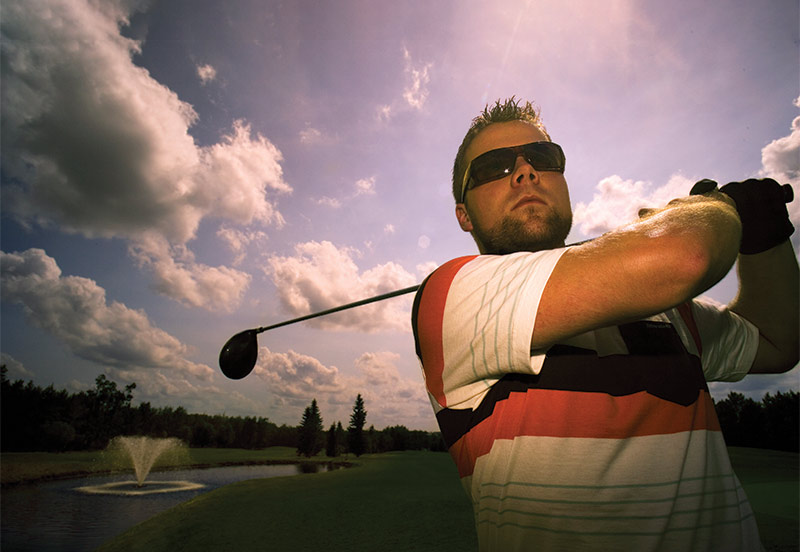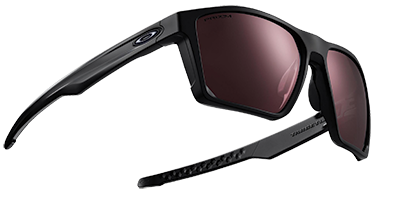By Barry Santini

How many times have patients asked you, “Can you tint my old glasses into sunglasses?” In the years past, encountering this query was not uncommon. But at its very core, this question reveals what an incomplete job eyecare professionals have done on educating eyeglass wearers on what constitutes a proper sunglass.
Today, looking beyond the familiar polarizing, UV-protective and blue-blocking sun lenses, we’re about to witness an advanced, activity-specific era in sun filtration that goes beyond the one-size-fits-all approach we offered when we tinted an old pair of prescription lenses. It is the dawn of the performance sunglass. At the vanguard is a group of almost 30 million people, about 10 percent of the U.S. population: golfers. They have a proven track record and a willingness to spend discretionary dollars in pursuit of the promise of improved performance.
According to the National Golf Foundation, the “core” golfer plays an average of 37 full rounds a year and is primarily male with a mean age of 40. Professionally educated with an average income of $104,000, core golfers are very focused on products that promise to improve or enhance the golf experience. Core golfers are responsible for 87 percent of all rounds played, and the same percentage for money spent on equipment. As the average round lasts four hours, core golfers spend almost 150 hours per year immersed in a targeted activity taking place mostly under the intense rays of the sun. Addressing the negative effects this much solar exposure can deliver is the primary reason everyone should wear sunglasses during golf. But ensuring proper eye health alone is not enough. Using sun tints such as blue or very dark gray can actually impede the performance of a golfer. Research completed in 2008 by Nike concluded golf is the most visually demanding sport. With this in mind, it’s time eyecare professionals learn not only which sunglasses work best for golf, but also the reasons and science behind these sophisticated performance sunglasses.
THE VISUAL ENVIRONMENT OF GOLF
As an outdoor sports activity, let’s take a quick look at the conditions that make up the environment on a golf course:
Variable Lighting Conditions—During a four to five hour round of golf, ambient lighting levels often vary from bright, sunny conditions to darkly overcast. As low level cumulonimbus clouds move past the sun, golfers contend with a wide dynamic range of illumination and shadow.
Varying Distances—From teeing off a 500 yard par-5 hole, to sinking a 5 footer on the green, very few sports require critical visual evaluations across distances that can vary by a factor of up to 300 times.
Varying Backgrounds—The task of distinguishing and following a white 1.68 inch ball against backgrounds that include light sand, green grass, brown trees and overcast to bright blue skies, challenges the golfer’s eyes to the limit of human visual sensitivity.
Varying Ground Contours and Conditions—Local variations in elevation and pitch, contour, grass height and wetness of surface all must be properly factored and evaluated to control the direction of the ball.
Varying Wind Conditions—Amplitude and direction of ambient wind are important to all aspects of ball control in a round of golf.
All these considerations pose significant visual challenges for the eyes of the golfer.
DEPTH PERCEPTION
To visually track a golf ball against a variety of backgrounds or ground contours, maintaining depth of field is essential. Therefore, dark lenses featuring low transmittance levels are not conducive to good depth perception. Most performance lenses designed for golf feature transmittance levels approximately 15 to 20 percent greater than typical general purpose sunglasses.
CONTRAST ENHANCEMENT
Improving the eye’s ability to see and track a golf ball against varying backgrounds and light levels requires an enhanced view of the edge of the ball. To make a golf ball more distinct and easier for the eye to follow against the sky or ground, you need a sun lens that changes the eye’s habitual color response. These color response changes are accomplished by modifying the eye’s tristimulus curve, or firing profile of the eye’s conical color receptors. This results in an improvement in distinguishing and discriminating colors called chromatic contrast. Interestingly, the most recommended general purpose sunglass color, gray, is not favored for golf precisely because it is a neutral filter. Where increased visibility and edge enhancement of a golf ball is the goal, improving chromatic contrast will result in what performance sunglass engineers refer to as “ball pop.”
Blue Light Filtering—For the long expanses of grass found on a typical course, conquering the haze created by evaporation requires suppressing blue, the color most scattered by water vapor in the air. For this reason, a performance golf lens features colors that suppress the blue end of the spectrum, such as amber, brown and green. This reduction of blue light scatter is also desirable when following or tracking a ball against the sky.
With this understanding of the basics for enhancing visual performance on the course, let’s take a closer look at what needs to be visually accomplished on the fairways and the greens.
OAKLEY’S PRIZM DARK GOLF LENS
One of the most notable golf lenses released in the past few years is the Prizm Dark Golf from Oakley. It features the same performance benefits as its Prizm Sport Golf lens, but it’s a darker lens that is optimized for sunny days.
Features: The Oakley Prizm Dark Golf lens brings out fine detail with precise light filtering that’s specifically engineered for the golf environment. It enhances visual contrast, and the color of the lens has a more neutral aesthetic for those who prefer a more casual look on the course. The lens helps golfers see grass health and textures that might otherwise be missed, making it easier to see transitions between the fairway, fringe and rough. Improves contrast so golfers can spot differences to fine-tune their approach to the hole. The separation of colors creates more depth cues to gauge distance for any shot from the tee box to the green, helping golfers easily differentiate grass conditions and grain direction to predict ball speed.
COLOR, GLARE AND THE GOLFER’S EYE
Considering most of golf course real estate is grass, you might assume a lens emphasizing green above all other colors would prove superior for golf. But allowing too much green transmission to the eye can impede discriminating ground contours. Therefore, golf-specific tints should simultaneously:
• Filter short visible blue light, which reduces haze.
• Allow some long wavelength blue light, which improve ball visibility.
• Allow just enough green spectra to enhance visibility of ground contour.
• Suppress peak yellow wavelengths, which contribute to eye fatigue.
• Allow some red wavelengths to pass, which helps in reading grassy contours.
A lens featuring a saturated green color might highlight the grass as a whole, but the cues a golfer is seeking are actually much more subtle. According to the PGA, when a golfer “reads” a green, they’re trying to subconsciously process how the following factors will combine to influence both ball speed and trajectory during putting:
• Slope
• Grass length
• Moisture level (in and on the grass)
• Base (firmness of the green)
• Wind
• Grain (blades facing the same direction)
Visual evaluation of these factors is accomplished through discrimination of differences in the amount of light reflected by individual blades of grass. For this reason, most performance golf sunglasses do not use polarization. The golfer’s eye uses grass blade reflection and deflection to assess both ground contour and wind direction. The size, angle, wetness and sway of a blade of grass are visually enhanced by allowing its full reflectivity. With polarized lenses now rendered non-effective, the challenge is finding an alternative solution to reducing glare and eye fatigue on the course. Different companies employ different approaches. Some favor significant suppression of yellow, the color our eyes are most sensitive to. Others favor blocking more of the blue wavelengths on which eyes have the most trouble focusing. Each approach has merit, yet each company’s recipe will often yield a color profile different from their competitors. However, all are designed to enhance the golfer’s visual performance.
YOUR LENS CADDY: THE GOLF FRAME
So far, we’ve only discussed how golf performance lenses should be designed. But just as important is the engineering of the frame. Three characteristics are essential for a frame designed specifically for golf:
-
Lightweight—When a core golfer spends an average of four to five hours on the course, comfort is a major issue. Not only should the frame be lightweight, it should fit comfortably, stay in place and resist slippage—especially challenging in hot, humid weather. The best models will feature rubberized nosepieces and temple grips. Stability is crucial: During play, golf-specific eyewear should not distract. Heat resistance is also important. Composite plastics, titanium and nickel metals are favored for their ability to retain original shape and resist heat absorption.
- Wraparound Construction—Since golfers depend so much on peripheral vision, non-distorting lenses that fully wrap around the eye are essential to not only block glare, but also to deliver a wide unobstructed field of view. Most purpose-built golf frames feature 8 to 9 base lenses in a semi-rimless construction. When addressing the ball, a golfer often will prefer to have little or no frame to distract their eye or influence their posture. Frames should also position the lenses close to the face but with proper venting to facilitate air circulation and reduce fogging.
- Deep Lenses for Looking Down—This is perhaps the most significant fitting parameter when fitting a performance sunglass for golf. Nothing distracts or requires a golfer to unnecessarily modify their optimal head, neck and shoulder posture more than sunwear with lens and/or frame edges at or near their lower gaze angle when looking downward. Today’s most advanced frame styles address this problem by employing adjustable temples and bridges, which help to tailor-fit an uneven head and optimize the pantoscopic tilt of the lenses.
To combine all these qualities in a frame is not inexpensive, with retail pricing for performance golf sunglasses usually beginning at the $100 to $120 level.
THE EYE OF THE BEHOLDER: ARE PERFORMANCE SUNGLASSES A ZERO SUM GAME?
In the past, when pitching the benefits of a more sophisticated—and more expensive—sunglass to a prospective purchaser, most eyecare professionals would help justify the additional expense with a phrase such as, “It will also be good for everything else.” But with the advanced performance promised in today’s sophisticated golf sunglasses, using this justification may no longer be possible. Within the current marketplace, there is a cornucopia of filtering profiles and frame designs that are presented as optimal for golf. From the sporting nature of the frame’s design, to the higher than conventional lens transmittance levels, to the absence of polarization, many performance sunglasses intended for golf would not be an eyecare professional’s first choice for general use activities, such as driving or use in water and snow.
It’s a dilemma. The more purposeful and optimized a sunglass is for a particular activity, the less optimal it will be found for general use. Yet the same can also be said for most golf equipment: Who would want to wear their golf spikes during an early morning jog or a leisurely evening stroll?
TO POLARIZE OR NOT TO POLARIZE
For golf, that is the question most often debated. The best answer may actually come from something every eyecare professional already has at their disposal: the lifestyle questionnaire. Let’s face it, not every golfer is a core golfer. Nor does every golfer aspire to play at a high competitive level or on professional tours. Through careful employment of lifestyle questions, the eyecare professional can best guide a prospective purchaser on when to choose polarized lenses for golf. It all depends upon the degree to which that same sunglass would be used for other more general activities.
–BS
OPTICS AND THE GOLFER
The visual demands of golf dictate the importance of lenses absolutely free of distortion or power errors. Particularly with wrap sunwear, it is the ECP’s responsibility to ensure the lenses are free from localized waves or prism imbalance.
Golf’s variable lighting conditions favor lenses employing the convenience of photochromic properties. Frames featuring interchangeable lenses of varying densities, although less desirable than photochromics, may appeal to or prove better suited for particular players. Another approach has been to use a flip-up style sunglass. However, golf research has shown that the all-or-nothing light-blocking nature of flip-up sunglasses can actually compound visual fatigue.
Consistent with avoiding abrupt changes to the golfer’s eye, gradient density lenses have proven less desirable. A player’s dynamic eye and head motions can interact with the lenses’ gradient density area, decreasing lens performance on the course.
THE IMPORTANCE OF DEPTH OF FIELD
There is no sport where depth of field is more important than golf. Proper reading of extended ground contours on a large putting green requires an exceptional depth of focus be maintained. To ensure a player’s pupil avoids becoming overly dilated, which reduces depth of field, performance golf lenses are generally designed to transmit 15 to 20 percent more light, compared to a general purpose sunglass. These higher transmittance levels will also provide players who steadfastly resist wearing minor prescriptions with better overall vision.
OPTIMIZING THE RX FOR THE GOLFER
Ensuring a golfer’s eyes maintain optimal depth perception and contrast sensitivity means even minor corrections can help determine whether a challenging hole ends up scored with a birdie, par or bogey. Even if the patient declares, “I see just fine without glasses,” take the time to demonstrate how minor corrections will significantly improve their vision when wearing sunglasses.
When glazing most golf sunglasses, the use of newer, free-form designed and optimized lenses for these wraparound models is mandatory. Many name brand golf sunglasses today offer OEM prescription options. Whether made in partner labs or in-house labs, these companies marry their intimate knowledge of model-specific lens shapes and fitting parameters with their proprietary lens filtering technology to deliver the Rx wearer the most optimized and authentic performance from their favorite brand. Today, the old seat-of-the-pants, in-office prescription compensations can no longer compete with the clarity of these OEM sourced sunglasses.
For the presbyopic golfer, the choice of lens design is debatable. Traditional bifocals or progressives will often interfere with a player’s all-important downward gaze. Previous solutions included placing a “golfer’s” bifocal—a small, round segment—into the lower corner of one lens. These segments can either be ground by the lab, or an ECP can trim and apply one of the newer “stick-on” styles, available at minimal cost. Recent studies have shown that certain newer progressive lenses engineered specifically for use in golf have been well received by players.
FORE! THE ECP, EYE HEALTH AND THE GOLFER
Almost every consumer who walks into your office has heard about the need to block harmful ultraviolet radiation from entering their eyes. A few may even be aware of the need to block High-Energy Visible Light (HEVL), which are the shorter wavelengths at the blue end of the spectrum. Patients with a family history of AMD (age-related macular degeneration) will benefit from guidance on how to best manage solar exposure. Golfers who spend time in the sun during a single four-hour round can surpass what others might endure in a month. Such avid players are particularly at risk for accelerated development of cataracts, macular degeneration, pinguecula, keratitus and skin cancer around the orbital areas.
Today, no one is better suited than a neighborhood eyecare professional to guide a golfer in the selection of a specially designed and engineered sunglass that will protect their eye health and maximize visual performance. At a time when more and more people are using the tools and apps of the Internet to learn about and purchase sun protection for their eyes, an ECP’s long-term success rests in showing the value of a personalized sport sunwear dispensing dialogue that will improve not only their golf game, their visual health and… your bottom line. ■
The original version of this article was published in the April 2011 issue of 20/20.
Contributing editor Barry Santini is a New York State licensed optician and contact lens fitter with Long Island Opticians in Seaford, N.Y.












